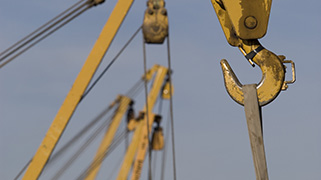
Lifting and Rigging Safety
Lifting and rigging work tasks are considered to be a high risk task by many companies. There are a lot of associated hazards that accompany lifting loads with cranes and lifting equipment. It is important to understand proper rigging techniques as well as other hazards involved with lifting. I highly recommend our suite of online lifting and rigging courses click here for more in depth training
Potential Hazards
Lifting and rigging involves many hazard. Equipment failure is the most commonly identified rigging hazard, including fatigue and breakage of slings, wire ropes or chains, resulting in dropped loads. While equipment failure incidents have the most severe impact and consequences, they are infrequent with the use of good Administrative Controls.
Less known is that many other types of less severe impact incidents related to lifting and rigging cause the majority of damage to workers, property and reputation. Some other injuries and incidents that occur frequently are sprains, falls, line of fire crushing injuries, electrocutions, and struck-by incidents.
Hazards related to swinging loads, manual handling of heavy rigging, holding needlessly to tag lines, moving equipment blind spots, fall potential on elevated working platforms, tripping hazards, slippery surfaces and more can all be present during lifting operations.
Safe Work Practices
- Anyone in a work area where a lift is being performed should be properly trained to perform the work scope, identify the hazards, and mitigate risks associated with their tasks.
- Have a written Lift Plan. A Lift Plan ensures the desired rigging, angles of equipment, lifting capacities, etc. are thought about prior to the start of the lift.
- Plan the travel path, lifting area and potential line of fire for rigging, crane and load prior the lift.
- Planning your travel path helps to avoid striking obstructions, workers or having to move objects and equipment in your travel path. Doing this once the load air born is far more hazardous.
- Inspect all rigging and accessories prior to use.
- Continuously check the integrity of equipment throughout the day if there are multiple lifts.
- All rigging should be properly preserved and stored after lifting operations are complete. Proper storage of your lifting and rigging equipment helps prevent damage related to the local environment, work site conditions hazards, worker activities and potential misuse.
- Keep away from all suspended loads. Stay clear of the swing radius and potential drop zone.
- Always strive to use tag lines or push sticks to ensure adequate distance from the suspended load.
Summary
This is not an exhaustive list of hazards and safe work practices related to lifting and rigging tasks.
Ensuring you participate in field level validation, online courses and proper classroom training can increase your knowledge of current and emerging lifting and rigging equipment available, local regulations, industry standards and best practices.
Proper planning and forethought is important to eliminate hazards and avoid incidents. Be aware of the hazards that affect you and your coworkers on each unique lift that is completed. Find out more click here of how you can keep yourself safe when working with Rigging and Slinging job tasks.